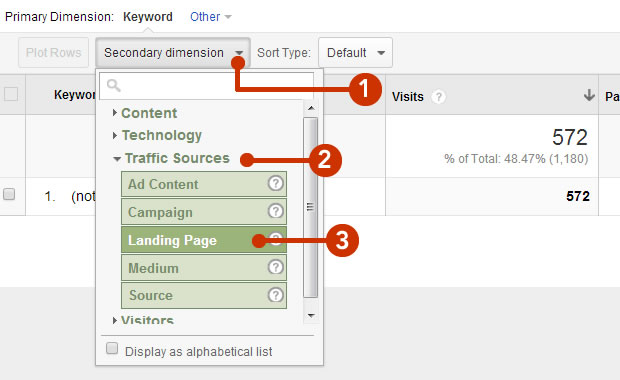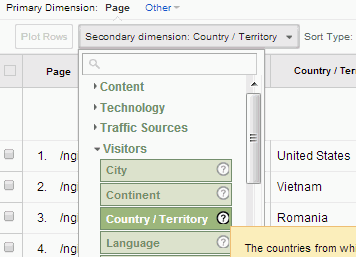Enhance Your Information Evaluation Using Secondary Dimension in Google Analytics
Discovering the capacities of secondary dimensions in Google Analytics opens a realm of opportunities for refining data evaluation. The capability to dissect information even more past the surface degree offers a nuanced view that can form calculated choices. By layering additional measurements onto main data sets, an even more intricate story emerges, shedding light on customer communications and performance indications. This vibrant technique to data exam holds the essential to unlocking concealed patterns and fads that might change exactly how companies analyze their digital impact.
Recognizing Second Dimensions
In the world of data evaluation, a crucial facet to grasp is the principle of secondary measurements and their relevance in drawing out deeper understandings from Google Analytics reports. Additional dimensions in Google Analytics describe added parameters that can be included in the primary dimension, permitting an extra comprehensive evaluation of information. By incorporating second measurements, analysts can sector and filter data to reveal patterns, patterns, and connections that could not be evident when checking out the data overall. These secondary dimensions can provide context and a more thorough understanding of customer actions, web traffic resources, and other crucial metrics tracked by Google Analytics.

Advantages of Making Use Of Second Measurements
When analyzing information in Google Analytics, the application of additional dimensions offers indispensable understandings into customer actions and performance metrics. By including an additional dimension to your key data, you can dive much deeper into the attributes of your internet site visitors and their interactions.
Additionally, second dimensions help in determining patterns and relationships that may not be immediately evident when checking out the data in isolation. This deeper level of analysis can discover beneficial information that can guide marketing approaches, site optimization, and general company decisions. Furthermore, secondary measurements enhance the context of your key information, providing an extra extensive view of individual interaction and efficiency metrics. On the whole, using additional dimensions in Google Analytics can substantially boost the deepness and top quality of your information evaluation, bring about even more enlightened decision-making and boosted end results.
Just How to Include Secondary Measurements
By including additional dimensions in Google Analytics, users can get much deeper understandings right into their information analysis procedure, permitting more comprehensive evaluation of individual behavior and efficiency metrics. Adding second dimensions is an uncomplicated process that can significantly improve the depth of analysis. To add an additional measurement in Google Analytics, start by navigating to the record you wish to assess. When in the report, find the "Secondary measurement" tab above the information table. Click on it to disclose a dropdown menu with numerous alternatives such as Behavior, Modern Technology, and Personalized Capacities. Select the dimension you wish to include, such as 'Source/Medium' or 'Gadget Classification'. This second dimension will then be applied to your existing information, giving additional context and enabling an anchor extra comprehensive evaluation of customer interactions. By using second dimensions properly, customers can uncover valuable insights that might have otherwise been overlooked, bring about notified decision-making and enhanced efficiency techniques.
Analyzing Information With Second Measurements
Utilizing additional measurements in data evaluation provides a much more extensive understanding of customer actions and performance metrics. By including a second measurement to your primary data established in Google Analytics, you can dive much deeper into the qualities of your web site site visitors and their communications. Integrating the primary measurement of 'source/medium' with the secondary measurement of 'landing page' can expose which details web pages are attracting website traffic from various resources, aiding you maximize these web pages for much better engagement.

Essentially, assessing information with secondary measurements empowers you to gain useful insights into customer actions, determine fads, and make informed choices to boost the performance of your digital homes.
Best Practices for Second Dimensions
In information analysis, incorporating second dimensions efficiently can dramatically enhance the depth of understandings derived from metrics and user behavior patterns. When utilizing secondary measurements in Google Analytics or any type of various other analytical tool, it is crucial to stick to ideal methods to guarantee the accuracy and significance of the data analysis.
One key best method is to thoroughly pick secondary measurements that match the main measurement being evaluated. Choosing additional measurements that give added context or additional segmentation can offer an extra thorough understanding of the data. It is likewise vital to prevent overcomplicating the over here evaluation by consisting of a lot of additional dimensions, which may result in complication or dilution of understandings.
Additionally, it is suggested to trying out various mixes of secondary and primary dimensions to reveal new relationships and trends. Frequently assessing and improving the choice of additional dimensions based upon the details objectives of the evaluation can cause even more actionable insights. By following these best practices, information experts can utilize second measurements successfully to boost the overall information analysis procedure and decision-making abilities.

Conclusion
Finally, including additional dimensions in Google Analytics is essential for a thorough data evaluation method. By leveraging second measurements together with main ones, marketing professionals and experts can uncover important understandings and relationships that can inform decision-making and enhance electronic advertising and marketing strategies. Understanding how to properly utilize additional measurements and adhering to best practices will enable experts to draw out purposeful information and boost their overall performance metrics.
Additional dimensions in Google Analytics refer to added specifications pop over to this site that can be included to the main measurement, permitting for an extra detailed analysis of data. By incorporating secondary dimensions, analysts can sector and filter information to uncover patterns, fads, and relationships that could not be evident when looking at the information as a whole. Integrating the primary measurement of 'source/medium' with the additional dimension of 'touchdown page' can reveal which specific pages are attracting website traffic from different sources, assisting you optimize these web pages for far better interaction.
One key best method is to very carefully select additional measurements that match the key dimension being examined. By following these finest practices, data analysts can utilize secondary measurements effectively to enhance the general data evaluation procedure and decision-making capacities.